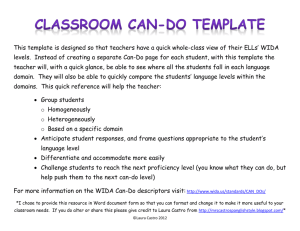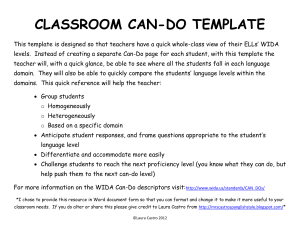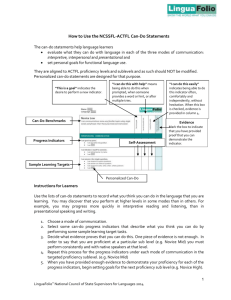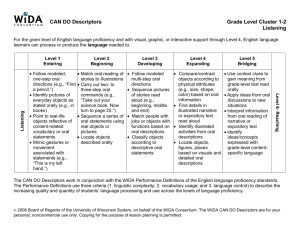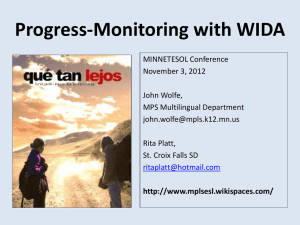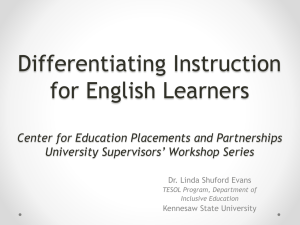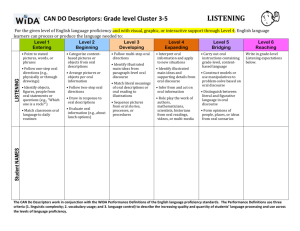EL Paraprofessional training - Mrs. Hilliker`s ELL and SIOP Toolbox
advertisement
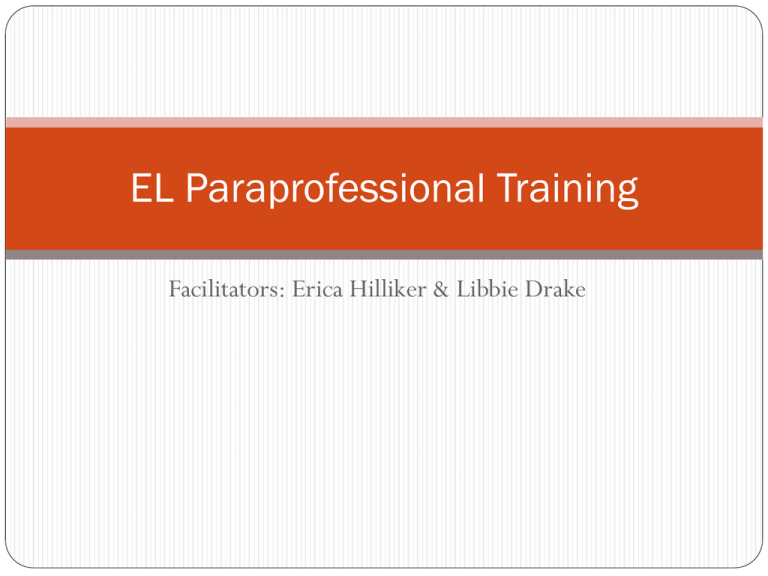
EL Paraprofessional Training Facilitators: Erica Hilliker & Libbie Drake Content Objectives The participants will identify: different levels of English proficiency and how those levels correlate to reading, writing, listening, and speaking abilities. characteristics of highly-effective paraprofessionals. support needed by English Learners before, during, and after instruction. English Learner support strategies. strategies for teaching new vocabulary to English Learners. Language Objectives The participants will discuss: The correlation of different levels of English proficiency to student’s reading, writing, listening, and speaking abilities. Support needed by English Learners before, during, and after instruction. Characteristics of highly-effective paraprofessionals. English Learner support strategies. Strategies for teaching new vocabulary to English Learners. Introductions Please introduce yourself to the rest of the group by sharing your - Name - Building - An experience that you have had being the inexperienced person in a group, class, or activity. Mission Statement (Pg. 2) Our role as EL educators is to prepare each student for college and career in a 21st century global community. Our objectives are: To ensure that students gain a foundation in the four language domains (reading, writing, listening, and speaking) and become comfortable and confident in communicating with others in English. To address the spectrum of students’ learning styles by using a wide variety of language teaching methods and techniques. To provide students with constructive, specific, and detailed feedback on all areas of their language development in order for them to understand their strengths and weaknesses and how they can most effectively develop their skills. Help students navigate and adapt to life at Godfrey-Lee and to the rigors of the American educational system. Think-Pair-Share How do you know if a student is an English Language Learner? Language Acquisition Cummins (1979): BICS (Pg. 3) Basic Interpersonal Communication Skills Involves using language for social, face-to-face and every day situations. Highly contextualized and provides lots of clues for comprehension. Takes 0-2 years to acquire Examples: Hi, how’s it going? Can I have a bathroom pass? Want to be my partner? Cummins (1979): CALP (Pg. 3) Cognitive Academic Language Proficiency Involves language skills and functions of an academic or cognitive nature. Language needed to accomplish academic tasks. Takes about 7-10 years to acquire. Examples: During Civil War times, most businessmen in the north made profits from industry. The sum of the squares of the legs of a right triangle is equal to the square of the hypotenuse. Can you explain the second phase of meiosis? WIDA Language Levels (Pg. 4) Level 1- Entering Students at this level do not understand or speak English with the exception of a few isolated words or expressions. . WIDA Language Levels Level 2- Emerging The student understands and speaks conversational and academic English with hesitancy and difficulty. The student understands parts of lessons and simple directions. WIDA Language Levels Level 3- Developing The student understands and speaks conversational and academic English with decreasing hesitancy and difficulty. The student’s English literacy skills allow the student to demonstrate academic knowledge in content areas with assistance. WIDA Language Levels Level 4- Expanding The student understands and speaks conversational English without apparent difficulty, but understands and speaks academic English with some hesitancy. The student continues to acquire reading and writing skills in content areas needed to achieve grade level expectations with assistance. Language Levels Video Language Levels Video-Debrief What differences did you notice with the student’s English proficiency in the video? WIDA- Can Do Descriptors What are Can-Do Descriptors? Can-Do Descriptors provide information on the language students are able to understand and produce in the classroom for each language domain: reading, writing, speaking, & listening. Can-Do Descriptors are a wonderful resource for understanding the language acquisition process and brainstorming ideas for differentiating classroom instruction and assessment. Can-Do Descriptors Puzzler Directions: 1. Locate your partner by finding the person in the room who has the birthday closest to yours. 2. Once you are in groups of two, remove the contents of the envelope you have been given. 3. Match the Can-Do Descriptors to the WIDA Proficiency Level and Language Domain they correspond to. 4. When you have finished, look at the Can-Do Descriptors Handout on Pg. 5 to check your work. Can-Do Descriptors Debrief How will you use the WIDA Can-Do Descriptors to help the students you support in the classroom? Instruction Wallpapering How can EL paras support students before, during, and after instruction? Record your ideas on post-its and place them on the corresponding white-boards. Before (Pg. 6) Assist students with developing an organizational system for academic success. Monitor that EL students are coming to class prepared with pencils, folders, binders, agendas, assignments, etc. Familiarize yourself with the proficiency levels of the EL students in the classrooms to which you are assigned. The grade-level EL teachers should have access to this information. During (Pg. 6) Encourage the use and acquisition of English. Encourage students to stay involved and participate during class. Avoid over use of translations. Try to use simplified English and gestures or images when possible. Review teacher’s directions in English first. Recognize the distinction between the support required in content-area classes versus EL classes. Utilize a variety of supporting techniques to accommodate the needs of EL students. After (Pg. 6) Encourage students to review the teacher’s directions for assignments. If possible, clarify concepts and model examples. Communicate to teacher areas of struggle and concern. Remember homework is practice, giving students the correct answers does not benefit them in the long run. Assessment Think-Pair-Share What type of support is appropriate for a para to provide a student during assessment? What type of support is inappropriate? Assessment: Tests & Quizzes(Pg. 6) The purpose of assessments can be two-fold: A check for understanding to guide further teaching A time for students to show what they know and are able to do Assessment is not a time for additional instruction. Assistance during assessments is only for clarifying student questions so they know what is being asked of them To maintain the integrity of an assessment, don’t provide clues and/or answers or walk students through a problem step by step. It would be appropriate to assist with unknown vocabulary words that are not related to the content being tested. Let’s Try It! The following is an example of a story problem a student might see on an algebra test: A rectangular swimming pool measures 20 meters by 10 meters. How wide must a concrete walk around the pool be if the walk is to cover an area of 124 square meters? Which of the words in the story problem would be appropriate to translate for an EL student? Paraprofessional Tips Think-Pair-Share What are the characteristics of a highly-effective EL paraprofessional? Qualities of Highly-Effective EL Paraprofessionals (Pg. 7) Models the behavior expected of students Comes prepared Teaches and models organizational skills Keeps accurate records of all worksheets, notes, and test dates. Knowledgeable of SIOP/EL Strategies and provides feedback to classroom teacher when asked. Participates in classroom activities Learns and knows classroom material Supports the classroom teacher by speaking with the teacher privately at a later time when issues or conflicts arise. Assists with discipline in a non-disruptive manner. More Qualities of Highly-Effective EL Paraprofessionals Circulates around the classroom Allows students to develop independence, and encourages interaction with fellow students and the teacher. Listens carefully to students and is observant of body language to determine when extra support is needed. Develop relationships. Learn about the home countries of the students. Have high expectations for students. Demonstrate appreciation for diversity. What to Avoid (Pg. 8) Interrupting instruction Correcting teacher Providing answers to students Making assumptions about students Engaging in side conversations during instruction Translating too much “Tattling” on students Supporting Techniques Think-Pair-Share What techniques have you found useful for supporting EL learning in the classroom? Simplifying Text (Pg. 9) Reduce the grammatical complexity, while keeping all essential information. Shorten the sentences. Change the verb tenses to simple present, present progressive, or past tenses. Change the passive voice to the active voice. Delete unessential information-but retain key vocabulary! Simplified Text Example Highlighting Text (Pg. 9) Sentence Stems/Frames (Pg. 9) Cognates (Pg. 10) Other Tips for Teaching ELLs (Pg. 11) Utilize visuals (real-life objects, photographs, drawings) Use gestures for added emphasis Adjust your speech: Speak slowly; enunciate; use longer natural pauses; repeat words or phrases Allow for sufficient response time Model for students Simplify Complex Directions Indicate pages numbers in text where answers to questions can be found Vocabulary for ELs Think-Pair-Share What are some recommendations you have for teaching vocabulary to English Language Learners? Key Vocabulary for ELLs (Pg. 12) Academic Vocabulary Examples Content Words Graph, axis, y-intercept Process or Function Words Locate, determine, identify Words and word parts Graph (Related words: (i.e., affixes, roots) that teach English structure Multiple Meaning Words Connectives photograph, geography, pictograph) Table, multiple, difference And, but, because Research-Based Tips for Vocabulary Instruction (Pg. 12) Direct instruction of words (provide student-friendly definition) Presenting the word in context. Visual support (pictures, definition in glossary) Translation of word. Using the words in the context of the lesson. Student interaction with words (activities and questions that make students use the words) Student internalization of definitions (retelling the definitions in their own words) Content Objectives The participants will identify: different levels of English proficiency and how those levels correlate to reading, writing, listening, and speaking abilities. characteristics of highly-effective paraprofessionals. support needed by English Learners before, during, and after instruction. English Learner support strategies. strategies for teaching new vocabulary to English Learners. Language Objectives The participants will discuss: The correlation of different levels of English proficiency to student’s reading, writing, listening, and speaking abilities. Support needed by English Learners before, during, and after instruction. Characteristics of highly-effective paraprofessionals. English Learner support strategies. Strategies for teaching new vocabulary to English Learners. Tickets Out- 3 W’s 1- Thing that WOWED you 2 -Things you’re doing WELL 3- Things you want to WORK on
